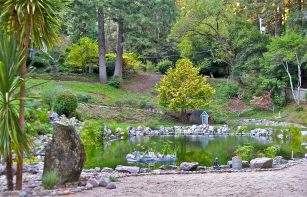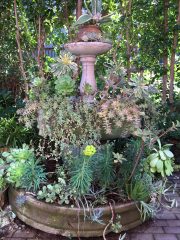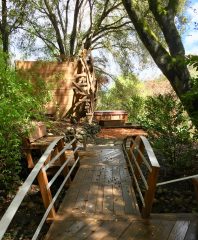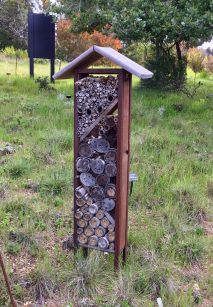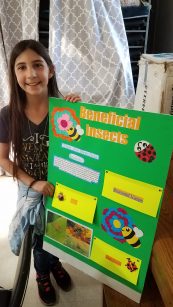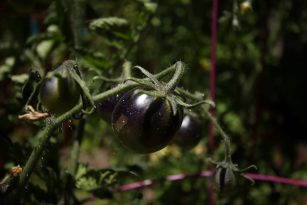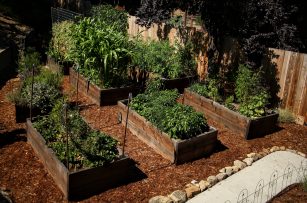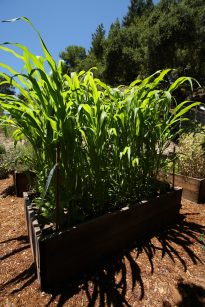Felton is celebrating its 150th anniversary this month. When I first came to this area I lived for 23 years in Felton so it?s close to my heart. My interest in early local horticulture started after looking at early family photographs of the homestead i where I used to live. My friends? family had a resort on Highway 9 before the turn of the century. Featuring a natural spring and rock-lined forest paths it was very near the Big Tree Grove resort, now known as Toll House which opened in 1867. I remember looking at the photos and marveling at all the flowers surrounding the dwelling. The redwood trees have now grown tall but back then there was lots of sunshine- a by product of clear cutting in the late 1800?s. I could see roses, lilacs and shasta daisies in the photo surrounding the wrap around porch.
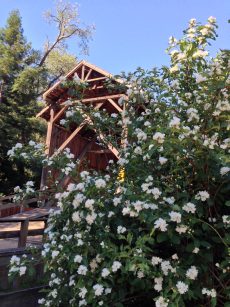
Most of this area was heavily forested until the late 1800’s. Boulder Creek, in 1899, was the 5th largest shipper of timber in the entire country. Quarry operations also used forest trees and shrubs to fuel the lime kilns in Fall Creek. Early logging techniques were very hard on the environment. Clear cutting was common and included the understory madrone and tan oak. After the removal of the broadleaf trees, the conifers were cut, to be followed by burning. To clear the bark from the logs and thin the shrub growth to facilitate with log removal, a fire was set. This first fire in itself was no problem since the trees could and would re-sprout from the base. But after removal of the logs by ox team, another fire was set and since these fires were uncontrolled, they would burn surrounding areas as well. The result was a sequence of fires that would kill the growing sprouts and saplings and allow invasion of shrubs, thus delaying the natural reforestation. Burning plus severe soil erosion at times so damaged the land that it could no longer support trees. In other areas the forest did not return until a long successional sequence of brush-land to woodland to forest had occurred.
So what could a woman do to make a house a home back in those days? Many settlers arrived from the east coast, the midwest and Europe and brought with them seeds and starts of plants. As early as 1871 nurseries in San Francisco were importing plants such as pittosporum tenuifolium and the 1915 Panama Pacific Exposition in San Francisco allowed many more plants to become available to homeowners. Hebe from New Zealand were all the rage. The brochure for the world fair describes a Palace of Horticulture and Tower of Jewels as …” a great garden, itself, a marvel of landscape engineering skill… one side of a magic carpet on which these beautiful palaces are set with its floricultural splendors for a wondrous beauty, has never been equaled.?
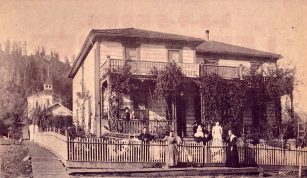
By 1905, residents of the area had settled in and planted fruit trees, vegetables and ornamentals. A photograph of a chicken ranch on Huckleberry Island shows lots of landscaping around the house. Certainly the available chicken fertilizer helped the roses and wisteria that appear in the pictures to bloom.
Up on Alba Rd. in Ben Lomond, the J.N. Walters family grew strawberries and peaches. Photos taken in 1915 show palms, and hollyhocks in their yard. Out on Bear Creek Rd., the Ercoli villa featured yucca which I saw in many other photographs. Most likely they originated from the deserts in the southern California and Mexico and were brought north by the missionaries.
California fan palms and canna lilies appear in many landscapes. The Middleton house in Boulder Creek was heavily planted with native western sword ferns. Black locust trees planted for their fragrance and flowers are still seen here today where they have naturalized. Originally planted for erosion control, particularly on strip mined areas, their durable timber was used for homes.
If your relatives have lived here a long time perhaps you have old photographs that show the plantings around their homes. If you?re willing to share I?d love to see them.

